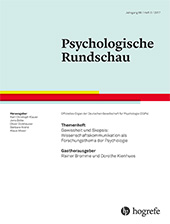Wissenschaftskommunikation in naturwissenschaftlich-technischen Museen aus psychologischer Sicht
Abstract
Zusammenfassung. Ausgangspunkt des Beitrags ist die wichtige Rolle von Museen und Ausstellungen für die Vermittlung wissenschaftlicher Befunde und Erkenntnisse an breite Bevölkerungsschichten. Diese Kommunikation ist sowohl durch spezifische Merkmale der Informationspräsentation als auch der Informationsrezeption in Museen gekennzeichnet. Im Rahmen des Beitrags wird aufgezeigt, dass die Anwendung lern- und kommunikationspsychologischer Theorien und Ansätze auf diesen Kontext und Inhaltsbereich zum einen zu einem tiefergehenden Verständnis der Informationsaufnahme und –verarbeitung sowie der Kommunikationsstrukturen in dieser komplexen Umgebung beitragen, zum anderen aber auch Hinweise auf die Anwendbarkeit, Tragfähigkeit und ggf. Erweiterung der jeweiligen Ansätze in komplexen ökologisch validen Lernumgebungen und Kommunikationssettings geben kann.
Abstract. This article looks at the important role of museums and exhibitions for communicating scientific findings and evidence to large groups of citizens. Science communication in museums is distinguished by its specific characteristics in terms of information presentation and its reception by the visitors. We show how current psychological theories of knowledge communication and knowledge acquisition may contribute to our understanding of communicating, acquiring and processing information in these complex settings. In turn, research in museums may enhance our understanding both of the ecological validity of these theories and of possible extensions and differentiations.
Literatur
(2009). Learning Science in Informal Environments. Washington: National Academie of Science.
(1999).
Content integration and source separation in learning from multiple texts . In S. R. GoldmanA. C. GraesserP. van den BroekEds., Narrative comprehension, causality, and coherence: Essays in honor of Tom Trabasso (pp. 209 – 233). Mahwah, NJ: Erlbaum.(2001).
Wissensdivergenz und Kommunikation: Lernen zwischen Experten und Laien im Netz . In F. W. HesseH. F. FriedrichHrsg., Partizipation und Interaktion in virtuellen Seminaren (S. 81 – 103). Münster: Waxmann.(2009). Scientific controversies in museums: notes from a semi-peripheral country. Public Understanding of Science, 18, 759 – 767.
(2016). Use of digital guides in museum galleries: Determinants of information selection. Computers in Human Behaviour, 57, 133 – 142.
(2009). Identity and the museum visitor experience. Walnut Creek, CA: Left Coast Press.
(2002). Lessons without limit. How free-choice learning is transforming education. Walnut Creek: Altamira Press.
(1998). The effect of visitors ‘agendas on museum learning. Curator: The Museum Journal, 41 (2), 107 – 120.
(2013). Informationswidersprüche im Museum. Einfluss von personalen und situativen Merkmalen auf die Verarbeitung konfligierender Informationen. Unveröffentlichte Dissertation, Universität Koblenz-Landau. http://kola.opus.hbz-nrw.de/volltexte/2013/944/
(2013). Fragile knowledge and conflicting evidence: what effects do contiguity and personal characteristics of museum visitors have on their processing depth? European Journal of Psychology of Education, 29 (2), 1 – 24.
(2014). Perception and evaluation of authentic objects: Findings from a visitor study. Museum Management and Curatorship, 29, 349 – 367.
(2015). The role of authentic objects in museums of the history of science and technology: Findings from a visitor study. International Journal of Science Education. Part B: Communication and Public Engagement, 5, 161 – 181.
(2012). Effects of split attention revisited: A new technology for troubleshooting tasks. Computers in Human Behavior, 28, 1254 – 1261.
(2007). Museums and education: Purpose, pedagogy, performance. New York: Routledge.
(2015). Materialien aus dem Institut für Museumsforschung, Heft 69. Verfügbar unter: http://www.smb.museum/fileadmin/website/Institute/Institut_fuer_Museumsforschung/Materialien/mat69.pdf
(2014). Comparing the Effectiveness of Two Communication Formats on Visitors’ Understanding of Nanotechnology. Visitor studies, 49, 159 – 176.
(2015).
Adressatenspezifische Aufbereitung von Wissen mit konfligierender Evidenz in Museen . In D. KienhuesR. BrommeHrsg., Das Verständnis fragiler und konfligierender Evidenz. (S. 26 – 27). Münster: WWU.(2015). The Cambridge handbook of multimedia learning (2nd Ed.). Cambridge: Cambridge University Press.
(2010).
From cold science to „hot research“ . In F. CameronL. KellyEds., Hot topics, public culture, Museums (pp. 129 – 149). Cambridge, Mass.: Cambridge Scholars Publishing.(1999). Cognitive Principles of Multimedia Learning: The Role of Modality and Contiguity. Journal of Educational Psychology, 91, 358 – 368.
(2002). Motivational factors and the visitor experience: A comparison of three sites. Curator: The Museum Journal, 45 (3), 183 – 198.
(2007).
Challenging Convention and Communicating Controversy: Learning Through Issues-Based Museum Exhibitions . In J. H. FalkL. D. DierkingS. FoutzEds., In principle, in practice: Museums as learning institutions (pp. 121 – 135). Lanham, MD : AltaMira Press.(under revision) Visitor motivation: Development of a short scale for comparison across sites.
(2004). Strategies for the curiosity-driven museum visitor. Curator: The Museum Journal, 47, 389 – 412.
(1982).
How do different readers learn with different text organizations? In A. FlammerW. KintschEds., Discourse Processing (pp. 87 – 97). New York: Elsevier Science Publishing Company.(2012).
Sozial und digital: Potenziale von Web 2.0 in naturwissenschaftlichen Museen . In C. Y. Robertson-von TrothaJ. M. MorcilloEds., Öffentliche Wissenschaft und neue Medien. (S. 57 – 68). Karlsruhe: KIT Scientific Publishing.(2014). Different media types – similar effects? Paper presented at the First European Conference on Audience Research and Evaluation. Berlin.
(2016). Representation equals presentation? Photographs of objects receive less attention and are less well remembered than real objects. Journal of Media Psychology, Advance online publication. doi:http://dx.doi.org/10.1027/1864-1105/a000166
(2014). Understanding and engagement in places of science experience: Science museums, science centers, zoos, and aquariums. Educational Psychologist, 49, 70 – 85.
(1998). Paying attention: Visitors and museum exhibitions. Washington, DC: American Association of Museums.
(2010). The participatory museum. Santa Cruz, CA: Museum 20.
(2014). Extending social cue based principles of multimedia learning beyond their immediate effects. Learning and Instruction, 29, 10 – 20.
(2009). Staging scientific controversies: a gallery test on science museums’ interactivity. Public Understanding of Science, 18, 79 – 90.



